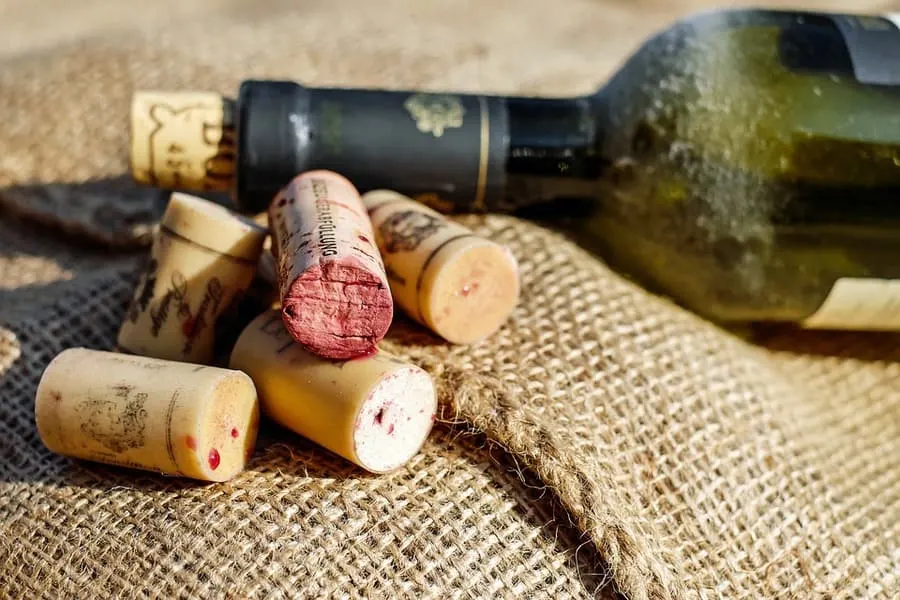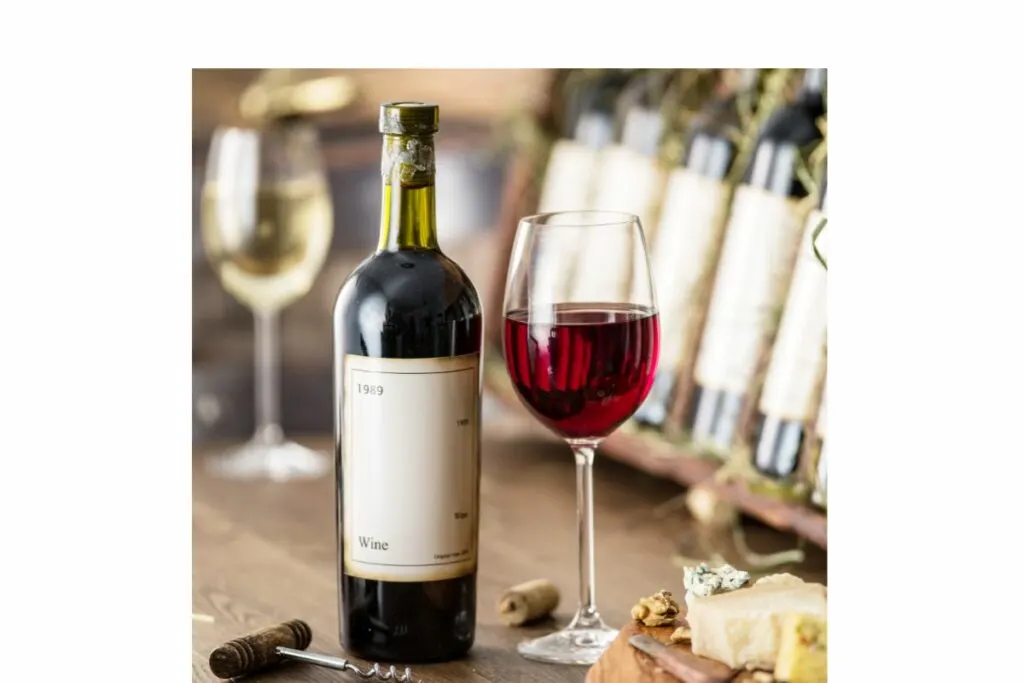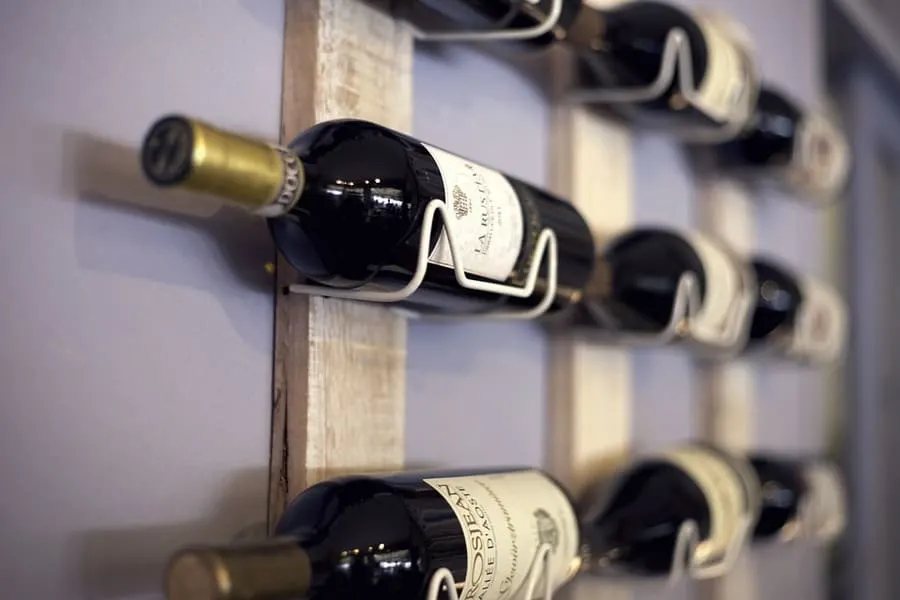As an Amazon Associate, I earn from qualifying purchases with no additional costs for you.
When it comes to storing wine and whether the cork needs to be in contact with the wine, everyone seems to have their own set of opinions. Some might say it’s an absolute must to lay the wine on its side for cork contact, while others believe this is a myth that shouldn’t be taken too seriously. With so many opposing opinions, it leaves one to wonder: what’s the verdict?
Should wine touch the cork in storage? Yes. A wine bottle should be laid on its side to keep the cork in contact with the wine. This keeps the wine from oxidizing, which leads to loss of flavor and, eventually, rotten wine. The only exception is sparkling wines, which have enough humidity to survive standing upright.
If you are still curious about the specifics when it comes to wine storage and keeping the cork in contact with the wine, then you’re not alone. There are a lot of details that go into keeping wine fresh while still allowing for proper aging. We’re going to discuss why you should keep the cork intact with the wine and how to properly store wine for the best results.

TIP: If you want to check out the best refrigerator for wine storage, I recommend trying out the Avation (18 bottles) compressor refrigerator with Wi-fi smart app control cooling system. You can find this refrigerator by clicking here (Amazon link).
Why Should Wine Touch the Cork in Storage?
When you go to take the cork off your wine bottle, you probably aren’t thinking too much about its importance. Sure, it keeps your wine from spilling out all over the refrigerator, but what else does this handy piece of equipment do? Well, you will be surprised to find out that this is a must-have piece of the puzzle when it comes to quality wine.
When your wine is topped with a cork, it prevents oxygen from reaching your wine. This is crucial because wine that has become oxidized will lose much of its flavor and may eventually become undrinkable (or worse).
Therefore, if you don’t want to completely ruin your wine for future drinking, then you should understand the importance of the cork.
Knowing the importance of the wine’s cork isn’t enough, though. You need to understand why it should always be in contact with the wine. The answer is this: when the cork begins to dry out, the cork will stop expanding in the neck of the bottle, thus letting air inside.
Any air (oxygen) that comes in contact with the wine is going to lead to premature oxidation. As we mentioned earlier, this causes the wine to become bitter and bland, losing all of its signature flavors and leading to a tasteless, repulsive glass you certainly don’t want to serve on date night.
TIP: Its important to store your wine properly. Find out why and how in this article. Are moldy corks safe and can you use them. Read this article to find out.
How to Make Sure the Cork Stays Wet
It’s important to keep the cork in contact with the wine. But now we need to discuss how you can always make sure the cork does not let any oxygen or air inside of the wine bottle. Here are a few must-know tips:
Always Keep the Bottle on Its Side
You have heard it once, and you will hear it a million times: wine bottles should always be stored on their side, especially if they aren’t going to be used for over 6 months. This is due to the simple fact that the wine bottle will be tilted, allowing the wine to make contact with the cork.
There are also some other great benefits to storing wine bottles on their sides, including:
- You save a lot of space. Wine bottles are tall and somewhat bulky, so standing upright can take up quite a lot of space. This is especially true if you are dealing with more than one bottle of wine. Well, placing the wine bottles on their sides ensures there is plenty of room for other bottles.
- They are easy to grab. If you are hunting for a specific bottle in your wine collection, it’s a breeze to pull your preferred wine out from a long row of wine bottles placed on their sides. It might seem like a small benefit, but it’s one you will enjoy when looking for a wine that’s just right for the occasion.
- It won’t harm your wine. While you don’t necessarily need to store a wine bottle on its side if you’re going to drink it soon or if the bottle is sealed off with a screw top or glass, there is no harm in doing so. If anything, you will be saving your wine from any potential
TIP: Having quality storage racks for your wine is not only practical but can also serve as a nice design accessory for your home. We loved these (Amazon links):
- Ferfil Wine Rack (10 Bottles): Concertina/scissor fold wooden wine rack made of solid, eco-friendly wood.
- Gusto Nostro Wood Wine Rack: Beautiful, elegant design, the possibility of storing up to 7 bottles, and the choice of vertical or horizontal storage.
Keep the Wine Bottle in a Humid Area
Placing your wine bottle on its side is a great start, but what about the rest of the cork? While being stored on its side, there are still going to be a few spots on the cork that are left untouched, and this can ultimately lead to oxidation at some point.
So how can you make sure you avoid this situation entirely? Here are a few more great storing tips:
- Keep wine in a humid area. The humidity will ensure that the cork stays moist, at least, so you don’t have to worry about the cork becoming dry in certain areas, which will lead to air seeping in and destroying your flavorful wines.
- The area should not be hot, though. A lot of people will associate humidity with high temperatures, but that isn’t necessarily the case, and should never be the case with wine.
One of the biggest enemies of wine is heat. Any temperatures above 70 degrees Fahrenheit can lead to a wine that ages rapidly. High temperatures can also lead to cooked wines that become flat, flavorless, and have an unpleasant odor.
That is why the ideal temperature for your wine is between 45 and 65 degrees Fahrenheit, with 55 degrees Fahrenheit being the ultimate goal.
- It shouldn’t be too cold, either. While you can get by with placing the wine in your fridge for a few weeks with no issues, it should be avoided if you’re planning to store it away for over 6 months. The lack of moisture found in cooler areas, such as the fridge, can cause the cork to dry out quickly.
Another important thing to keep in mind is that your wine should never be in an area where it could end up frozen. When wine freezes, it can ultimately expand and lead to the cork being pushed out entirely. This is a surefire to destroy your wine.
- Keep the temperature consistent. Another thing to control is temperature fluctuations. You never want to place your wine bottles in an area where temps go up and down regularly. Keep it at a consistent temperature to avoid the issue of the cork being pushed out from the constant expansion and contraction that comes from rapid temperature changes.
- Consider a humidifier. If your location isn’t naturally humidified, such as a basement, then you might want to consider buying a humidifier. Remember that the ideal humidity for wine is 50 to 70 percent. You can also add a pan of water to the room where you are storing your wine.
Make sure that humidity never goes over 80 percent. With such high levels of humidity, you pose the risk of mold growing in your wines.
This will make your wine smelly and off-putting, which leads to an undrinkable bottle. A study by Jung & Schaefer (2010) confirms that 60% of humidity should not be exceeded.
TIP: Wine should be kept at a certain temperature for the best results. I wrote these articles on the best storage methods for red and white wines.
Do All Wines Need to Touch the Cork in Storage?
One question that comes to mind is whether all wines need to follow the cork rule. This becomes one of the more debatable questions when it comes to wine storage.
At the end of the day, there are a few rules to follow and things to consider when it comes to corks being in touch with the wine in storage.
Champagne and Other Sparkling Wines Maybe an Exception
Champagne and other sparkling wines are made differently than other wines. They are designed to have 70 to 90 pounds of pressure in the bottle.
This is because these types of wines have an excessive amount of carbon dioxide inside them. But what does that have anything to do with placing the bottles on their sides?
Due to the high levels of carbon dioxide found in champagne and other sparkling wines, there is naturally a higher level of humidity, too. Knowing that high levels of humidity keep the cork moist, you don’t have to worry as much about the cork becoming dried out and ruining your champagne.
Does this mean you shouldn’t store it on its side and have the cork in contact with the wine? No. Just because you don’t necessarily need to store it on its side, doesn’t mean you shouldn’t. There is no advantage to keeping sparkling wines upright, so you may as well place it on its side.
Placing champagne and other sparkling wines on their sides is a great way to save space in your home while also ensuring that there is no issue with dried-out corks.
Again, it’s unlikely, but not completely impossible for your cork to dry out and oxidate your wine. Our advice: place these types of wines on their sides, if you can.
Madeira
Because Madeira is unique in that it does not need to be placed on its side to stay fresh and succulent. However, it also isn’t loaded with carbon dioxide to keep it moist. So what’s the deal when it comes to Madeira?
Madeira is uniquely constructed to be long-lived and is fortified to be oxidized. In other words, you don’t need to be concerned with wine that’s already been oxidized, becoming more oxidized; it really won’t make a difference.
Again, this doesn’t mean that you should avoid placing this wine on its side. There are no disadvantages to doing so, so if you want to remain completely confident that your wine won’t become overly oxidized, then lay it on its side. You will also save plenty of room in the meantime, and that’s something everyone can enjoy.
Does the Cork Need to Touch Wine That’s Being Drank Immediately?

Another common cause for concern is whether or not a wine that’s going to be drunk immediately needs to be placed on its side. The simplest answer to this question is this: no. If you are planning to drink the wine within the next week or two, you do not have to worry about the wine touching the cork at all times.
The cork on a wine that will be opened within a few weeks won’t have time to dry out. This means that you shouldn’t worry about placing the bottle on its side or finding a humid spot for the wine to relax and age. You can be confident placing your wine upright in the fridge, as long as you drink it within a few weeks.
If you are worried about your wine going flat after it has been opened, there are a few simple tips and tricks to make sure it stays fresh:
- Always re-cork the wine immediately. But while it may seem tempting to place the clean side of the cork back into the wine, you want to choose the stained side. The stained side of the cork has the flavor of the wine, while the clean side may not be so ‘clean.’ This can change the flavor of your wine and make it less enjoyable.
- Place the wine in half bottles. Too much air exposure will lead to flat wine, and that can easily be avoided by pouring half of the wine into a different screw-cap bottle. It’s okay if there is a little extra air at the top, as it’s still a much better solution than regular bottles.
- Place it in the refrigerator. Placing at a cooler temperature will help to stop the breakdown of the wine, ensuring it stays fresh for at least a few days after it has been opened.
- Drink within a few days. After your wine has been opened, you should probably consider consuming it within a few days. After this point, the wine may chance flavor and lose its aroma as well as flavor.
Keep in mind that these tips will only work on wine that is going to be drunk quickly. If you’re planning to store the wine and let it age, it should be opened whatsoever until it is ready to drink.
TIP: Leftover wine can be safely stored to use later. Corks and wine stoppers are successfully used for this purpose.
Should a Wine Cork be Wet?
At this point, we all know that a wine cork should be in contact with the wine and be moist. But should it necessarily be wet? No, a wine cork should never be wet or soaked. It should be moist at most, providing enough moisture to keep oxygen and air from seeping into the wine and creating an unpleasant flavor and odor.
So how can you make sure your cork is doing its job correctly? What are some of the signs of a cork that is too wet, or simply not keeping your wine safe from oxygenation? Here are a few things to look out for:
- A bulging cork. A bulging cork that’s coming out from the top of the bottle can be an indicator that the wine has suffered from heat damage, and the flavor will likely be damaged.
- A raised cork. On the other hand, a raised cork can simply mean that the winery made a mistake when sealing the bottle. This is more likely found in wine bottles that are sealed with cheap or synthetic corks. A bad-sealing cork will either make the wine oxidize due to the lack of a proper seal or prevent it from adequately aging and becoming more delicious due to the lack of oxygen.
- A soaked cork. You want your cork to be stained and moist from the wine, but you never want the cork to be entirely soaked in the wine. An overly wet cork means that it was no sealed properly, and the wine has seeped up and around the edges of the cork.
- A crumbly cork. A cork that has become crumbled is not able to properly seal the wine and keep it from oxygen. Therefore, this wine will likely have spoiled as it’s succumbed to an excess amount of air.
These are all indicators that cork has gone wrong and is not doing its job. Even if you do end up trying to enjoy the wine, you will end up with a musty, bland wine that is anything but fruity or refreshing. A lot of the time the wine will appear to have a darker shade than the original, such as a red wine turning an odd brown hue.
Recommendation box: Everything you need to enjoy your wine as much as possible. All recommended products are personally tested and regularly used by experts from this website (Amazon links):
> Ivation Wine Cooler – Energy-efficient wine cooler for 18 bottles with Wi-fi smart app control cooling system.
> Wine Rack – Beautiful, elegant wood rack for up to 7 bottles and the choice of vertical or horizontal storage.
> Durand Wine Opener – Classic vintage wine opener (we like all these classic staff).
> YouYah Iceberg Wine Decanter – The most beautiful and handy wine decanter we personally use.
> Bormioli Rocco Wine Glasses – A set of eight elegant and traditional wine glasses made in Italy.
> Vintorio Wine Aerator – Simple but really useful wine aerator for a reasonable price.
> The Original Vacu Vin Wine Saver – The best wine saver on the market in a package with two vacuum stoppers and two wine servers.
And if you want to become a true connoisseur of wine, we recommend reading the book Wine Folly: The Essential Guide to Wine (Amazon link), where you will find all the information you need about winemaking, wine varieties, flavors, and much more.
Conclusion
While there may be different theories when it comes to whether wine should be placed on its side, the fact is that a cork that is moist from being touched by wine and placed in proper humidity will keep the wine from oxidizing.
Oxidation will destroy the wine in terms of flavor and aroma, and therefore it is highly recommended to place wine on its side.
TIP: Check out this page for a complete list of wine products and accessories I love. You’ll find my recommendations for wine refrigerators, decanters, and aerators and the best place to buy wine online. Click here to see the complete listing.
Scientific Literature Referenced:
Jung, R., & Schaefer, V. (2010). Reducing cork taint in wine. Managing Wine Quality, 388-417. DOI:10.1533/9781845699987.388 (via: ScienceDirect)

